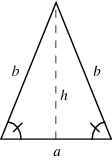Hello Everyone!
I tried looking for a post similar to this but couldn't find one. Regardless, I spent a long time proving this little geometric rule, one which I learnt a long time ago. So, as a refresher for everyone preparing for the GMAT, here is a simple, time saving method for calculating the height of a 45-45-90 isosceles triangle.
Height = 1/2 * baseAs simple as it gets! I am sure a lot of you know this but I will show the proof below:

Figure 1: Isosceles Triangle taken from
https://mathworld.wolfram.com/images/eps-gif/IsoscelesTriangle_800.gif1. In the triangle above, the base has been bisected by the line
h, essentially dividing the original triangle into two smaller ones. The base of the new triangles are both 1/2
a.
2. The angles marked are both 45 each, as is the case with all isosceles triangles. Therefore, [tan 45 =
h / (1/2 *
a))]
3. Since tan 45 degrees = 1, the relationship is now [1 =
h / (1/2 *
a)]
4. If you balance the equations, you get [1/2 *
a =
h]
a is your base and
h is the height.
There are even easier ways to find the height, once you understand the concept. Take the two smaller triangles that you divided the main triangle into. You know that one side is 45 and the other 90. This means that those triangles are isosceles too and you can just eye the missing side without calculating anything!
There you have it, a small proof that hopefully goes a long way!
Edit: only works for 45-45-90






